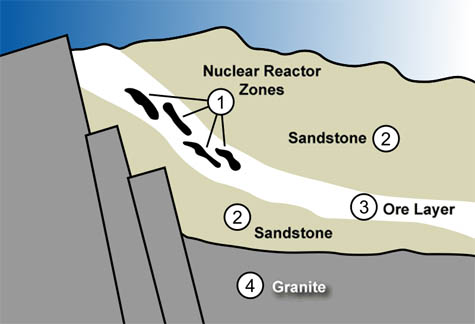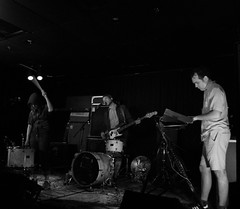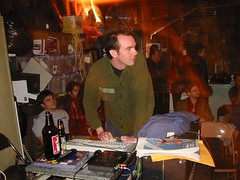The following post stolen from BLDGBLOG:
Fossil Reactors: "There are as many as sixteen two-billion-year old nuclear reactors locked in the rocks beneath
Gabon. Unsurprisingly, at that age, they are also completely natural.
 [Image: The natural clocks and ticking stratigraphy of the Oklo uranium deposit, courtesy of the Curtin University of Technology].
[Image: The natural clocks and ticking stratigraphy of the Oklo uranium deposit, courtesy of the Curtin University of Technology].'In 1972,' the
Curtin University of Technology explains, 'the very well preserved remains of several ancient natural nuclear reactors were discovered in the middle of the Oklo Uranium ore deposit.' The university adds that each of these equatorial African reactors 'operated on an intermittent basis for a period ranging from a few years to hundreds of thousands of years. The total time period over which the reactors operated is thought to be about a million years.'
In one specific case, we read in a report published five years ago by
Physical Review Focus, a chain reaction in the uranium-rich rocks 'cycled on and off every three hours.'
The idea that radioactive deposits beneath the Earth could self-react and undergo fission was first proposed by physicist Paul Kazuo Kuroda. The internal clock of a geological formation, Kuroda suggested, given contact with water, could simply start ticking away:
In 1956, nuclear chemist Paul Kazuo Kuroda of the University of Arkansas in Fayetteville predicted that a chain reaction could develop in natural uranium deposits, generating heat just as the reactor in a nuclear power plant does. His suggestion proved prophetic when, in the 1970s, others discovered several burned-out natural reactors in the Oklo uranium mines in Gabon.
Amazingly, 'researchers still don't know precisely how the fossil reactors managed to burn slowly for more than 150,000 years, when they could have exploded violently.' The presence of underground water seems especially fortuitous in that regard—it helped to avoid a nuclear detonation.
That's plausible because the water molecules would collide with neutrons whizzing through the uranium and slow them down, a process called moderation. Because slower neutrons more efficiently split the uranium nuclei in a chain reaction, the water would promote the reaction and cause the reactor to heat up. Eventually, however, the heat would boil away the water, shutting the reaction down until more water could collect.
It was a pulsing rhythm, a geologic throb: based on present-day chemical measurements taken of specific isotopes in the nearby rocks, 'the researchers estimate that the reactor ran for 30 minutes and then shut down for two and a half hours.'
 [Image: A diagram of the Oklo uranium deposit, courtesy of the U.S. Department of Energy].
[Image: A diagram of the Oklo uranium deposit, courtesy of the U.S. Department of Energy].I'm reminded
again here of William Burroughs's extraordinary and haunting suggestion, from his novel
The Ticket That Exploded, that, beneath the surface of the earth, there is 'a vast mineral consciousness near absolute zero thinking in slow formations of crystal.' Here, though, it is a mineral seam, or ribbon of heavy metal—a riff of uranium—that stirs itself awake in a regularized cycle of radiative insomnia that disguises itself as a planet. Brainrock.
Gabon's '
natural nuclear fission reactors,' according to Wikipedia, 'are the only known sites in which natural nuclear reactors existed. Other rich uranium ore bodies would also have had sufficient uranium to support nuclear reactions at that time, but the combination of uranium, water and physical conditions needed to support the chain reaction was unique to the Oklo ore bodies.'
Of course, this process created what we would now call
nuclear waste—including plutonium. These otherwise extraordinarily dangerous waste products, however, have been entombed within the earth for two billion years. The
Curtin University of Technology points out that 'this is so long that all of the radioactive waste products (even those with million year half lives) have decayed away.' They have also hardly even moved: the plutonium, according to the U.S.
Department of Energy, 'has moved less than 10 feet from where it was formed almost two billion years ago.'
Are there thus structural lessons to be learned from the rocks at Oklo? 'By analyzing the remnants of these ancient nuclear reactors and understanding how underground rock formations contained the waste, scientists studying Oklo can apply their findings to containing nuclear waste today,' the DOE goes on to suggest. This is another way of saying that the Oklo uranium deposits are being studied as natural analogues for how high-level nuclear waste might behave in an artificial repository like
Yucca Mountain (watch for a long and fascinating interview with a geophysicist from Yucca Mountain here on BLDGBLOG next week).
We might say, then, that a geological formation, like some nuclear version of Spanish architect Vicente Guallart's notion of
geologics, has partially inspired an architectural form.
The timescales are all wrong for this, meanwhile, but if
geomythology is the study of ancient folk tales, oral traditions, and regional myths to see if they contain camouflaged references to real, but prehistoric, geological events—earthquakes, tsunamis, volcanic eruptions, and more—what geomythological influence might the throbbing and automechanized Oklo uranium mines play? How extraordinarily interesting would it be to come across a series of old myths about an intelligent presence in the rocks of equatorial Africa, a kind of mineralized Mother Nature winking at everyone from below—and to realize that they're referring to the reactions at Oklo. A spirit in the Earth.
Finally, do these naturally occurring reactions come with the implication that our present-day nuclear reactors are, in a sense, simulated geological processes, not unlike artificial diamond-creation chambers? Nuclear reactors become models of already existing natural events. They are
terrestrial reenactments, you might say.
Scientific American has a five-page article about the Oklo phenomenon, if you'd like to read more.
"

 This is the LP jacket, illustrated by Raul Gonzalez. When discussing the design with him, I knew our budget would be limited to a single color print on a large two-sided fold-over sheet. Knowing his background in sequential art, I asked him to include the namesake poem (Written by RC Weslowsky, found on the google, and used by permission) in its entirety as word balloons. He ingeniously had the text spoken by various mutations of popular comic characters, including the nefarious Yassy Goldie.
This is the LP jacket, illustrated by Raul Gonzalez. When discussing the design with him, I knew our budget would be limited to a single color print on a large two-sided fold-over sheet. Knowing his background in sequential art, I asked him to include the namesake poem (Written by RC Weslowsky, found on the google, and used by permission) in its entirety as word balloons. He ingeniously had the text spoken by various mutations of popular comic characters, including the nefarious Yassy Goldie. Here is the official mp3 album art. It was designed by Ben Sisto. He's a Brooklyn-based artist and promoter, though he may not differentiate the two acts. I've always admired Ben for his optimistic futurism, and when I came up with the two-format idea I immediately thought of him for the digital side. The design was created in Adobe Illustrator and as far as I know has never been printed out. The image is included in the metadata within the mp3s as they are freely provided at Inman Street Records.
Here is the official mp3 album art. It was designed by Ben Sisto. He's a Brooklyn-based artist and promoter, though he may not differentiate the two acts. I've always admired Ben for his optimistic futurism, and when I came up with the two-format idea I immediately thought of him for the digital side. The design was created in Adobe Illustrator and as far as I know has never been printed out. The image is included in the metadata within the mp3s as they are freely provided at Inman Street Records.

 [Image: The natural clocks and ticking stratigraphy of the Oklo uranium deposit, courtesy of the
[Image: The natural clocks and ticking stratigraphy of the Oklo uranium deposit, courtesy of the  [Image: A diagram of the Oklo uranium deposit, courtesy of the U.S.
[Image: A diagram of the Oklo uranium deposit, courtesy of the U.S. 




